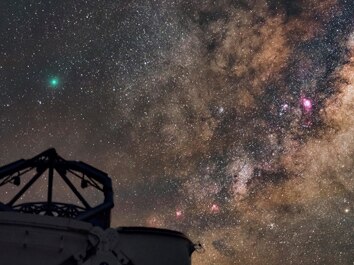Create a free profile to get unlimited access to exclusive videos, sweepstakes, and more!
An Emerald Green Comet and a Billion Stars

I’ve said many times that there are no green stars, but that doesn’t mean there are no green objects in space.
My pal Babak Tafreshi makes this point beautifully in his phenomenal photograph of the night sky over the Paranal Observatory in Chile:
Oh my. Isn’t that gorgeous? In the foreground is one of the four smaller auxiliary telescopes that make up the Very Large Telescope Interferometer, a sophisticated piece of equipment that can take observations with far higher resolution even than Hubble. And by smaller, it’s a 1.8-meter wide mirror; that’s only small when compared to the 8.2 meter behemoths that make up the Very Large Telescope!
But that sky. To the right of the telescope blazes the billions of stars of Milky Way, our home galaxy, partially obscured by dark dust lanes and punctuated by the pink glow of hydrogen in the Lagoon Nebula.
But that green fuzzy glow above the telescope somehow manages to steal the show, perhaps because its color makes it stand out in stark contrast to the other objects in the sky. That emerald blob is the comet 252P/LINEAR, which passed the Earth in mid-March at a close distance of more than 5 million kilometers.
Many comets glow green; it’s due to the presence of a molecule made of two carbon atoms (C2), so that’s not a big surprise. But that’s about the only nonweird thing about 252P.
It turns out it was full of surprises. For one thing, it was followed closely by another comet, P/2016 BA 14, which had a very similar orbit, sparking hypotheses that they were once the same object that split. Both passed very close to Earth (the fourth and seventh closest passes of comets in recorded history).
This gave astronomers a chance to observe BA 14 with radar and lead to another surprise: BA 14 was way bigger than first thought. From its brightness it was at first estimated to be less than 200 meters across, and probably much less. But the radar observations showed it was more like a kilometer across! It turns out the solid nucleus of BA 14 is incredibly dark, reflecting less than 3 percent of the light that hits it. That makes it fainter than expected, which is why astronomers thought it was small.
Around the same time, 252P had a huge outburst, suddenly becoming 100 times brighter in a short period of time. It went from obscurity to becoming naked-eye visible, though unfortunately for us in the Northern Hemisphere it was too far south to see. But that was good news for Babak, who was able to capture it in the photo above while he was visiting the European Southern Observatory facilities.
It’s rare, but sometimes comets flare in brightness. This can happen if they clave (split off a piece), which can release a lot of ice that turns into gas; that reflects sunlight and makes the comet brighten. In 2007 Comet Holmes underwent a tremendous outburst that made it easily visible to the naked eye even though it was out past Mars; it’s brightness increased by a factor of a million! I was fortunate to be in a place where I could see it, and it showed a disk easily to the naked eye; the cloud was more than 1 million kilometers across. I’ve never seen anything like that before, nor since.
Which goes to show you, it always pays to keep your eyes on comets. Sometimes they fizzle, but when they perform, they can really perform, and all the time spent watching them can suddenly pay off.


























